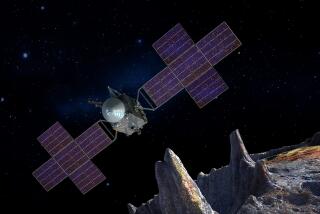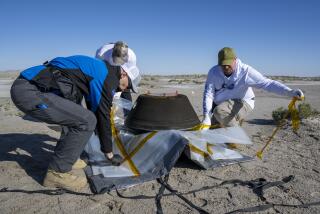The Earth’s 500,000-Mile Near Miss
On March 23, 1989, Earth had another close call. A small asteroid, about half a mile across, whizzed past at a distance of about 500,000 miles, about twice the distance from the Earth to the moon. That sounds like a safe distance, of course, and “a miss is as good as a mile,” they say.
However, that rock is following an orbit that nearly crosses Earth’s and every once in a while (a fairly long while), Earth and asteroid reach the crossing point at the same time and it gives us one of these close-call whizz-bys.
We might argue that 500,000 miles, or possibly a little closer, may be as close as it can possibly come if the orbits stay as they are, but they won’t. Earth is a massive body and its orbit is quite stable, but the asteroid is a tiny thing in comparison and it is subject to the pull of Earth and moon and Mars and Venus as it moves so that its orbit is constantly shifting a little.
Its orbit may shift so as to carry it farther from Earth, or possibly closer. To be sure, there is much more room away from Earth than closer, so the chance of its moving into a collision course is very small, but it’s not zero.
The trouble is that this asteroid is not the only one, either. In 1937, an asteroid that astronomers named Hermes passed within 200,000 miles of Earth, and it was larger than this one that just missed us. It may have been a mile across.
And on Aug. 10, 1972, a small object, only 40 feet across, perhaps, actually passed Earth at a distance of only 30 miles above the surface of southern Montana--and whizzed on. It had passed through our stratosphere.
Some astronomers think there may be at least a hundred objects that are half a mile or more across and that have orbits that send them skimming by Earth. And there may be thousands that are a few dozen feet across. Obviously the chance that perhaps one out of all these will finally strike Earth is far greater than the chance that a particular one, like the one that just missed us, will do so.
Even a comparatively small object like the one that missed southern Montana could do fearful damage if it struck. If it hit land, it would gouge a sizable crater. After all, these projectiles can be moving 20 miles a second as they hit Earth.
An object half a mile across, like the one that just missed us, would hit with the force of 20 billion tons of TNT. If it struck New York, it would undoubtedly wipe out the entire city and kill millions of people in an instant. If it struck the ocean it might be even worse, for the water in the ocean would slosh tremendously and huge “tidal waves,” mountains of water hundreds of feet high, would crash onto neighboring shores and drown tens of millions.
If the object is bigger still, it might puncture Earth’s crust, set off volcanic action, start worldwide forest fires, drown half the continents and cast so much dust up into the stratosphere as to cut off sunlight for a long period. Such a huge strike might kill most or all of life and, indeed, such a huge strike is thought by many to have wiped out the dinosaurs 65 million years ago.
Lesser collisions have happened recently. In Arizona, there is a crater four-fifths of a mile across and 600 feet deep that formed perhaps 50,000 years ago as a result of a collision. It probably didn’t kill anyone because human beings had not reached the Americas yet. In 1908, a much smaller strike in central Siberia knocked down every tree for 20 miles around, but it was a desolate, uninhabited region and nobody was killed.
In fact, there is no record in historic times of any human being being killed by a meteoric strike--but we can’t stay that lucky forever.
What can we do about it?
Thirty years ago I wrote an essay that appeared in the August, 1959, issue of Space Age called “Big Game Hunting in Space.” In it, I advocated the establishment (once we had the ability to do so) of a space sentinel that would watch for any nearby object more than a few feet wide that might be approaching. It might then be blown up by a hydrogen bomb planted in its path, or by something more advanced. (It would be a “Star Wars” defense aimed at asteroids rather than at enemy missiles.)
As far as I know, I was the first to suggest this, but since than, astronomers have discussed the problem very seriously. After all, there are estimates that a “city-busting” strike might happen, on the average, once in 50,000 years, and it’s been that long since the Arizona crater. We might be due, so to speak.
Of course, if we smash up a small asteroid, the rubble will continue in its orbit, perhaps, but then if that does strike the Earth, each individual bit can’t do much damage. Instead of having a huge crater gouged out, we’ll be treated to a brilliant meteor display as the small pieces burn up in the air, or land as small rocks.






